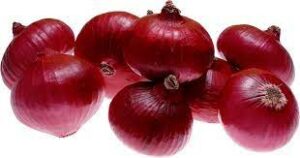Looking for an Onion Farming Guide in Nigeria as an academic, agro-investor or researcher? Read this article to know more.
Onion farming is both incredibly simple and lucrative. Onion plant care is likewise relatively low, and very little capital is needed to cultivate onions on a commercial basis. So now we discover the best practices for growing onions.
READ – DOWNLOAD ONION FEASIBILITY STUDY PLAN

With enough drainage, onions may be grown in a variety of soil types, from sandy loam to clay loam. pH between 6.5 and 7.5 would be ideal. It can withstand temperatures between 13 and 24 degrees Celsius for the vegetative stage, 16 to 21 degrees Celsius for the bulbing stage, and 30 to 35 degrees Celsius for maturity and harvest. Mild weather without extremes of cold, heat, or excessive rainfall is excellent for performance.
Nursery raising of Onion seedlings:

Raised beds that are 1.2 m wide and 3–4 m long are used to plant seeds. In 45-50 days following seeding, the seedlings will be ready for transplantation.
When you do your final plowing, add 20 tonnes of FYM per hectare, or 10 tonnes of FYM and 5 tonnes of chicken manure or vermicompost. For planting, create a flatbed or broad-based furrow (BBF).
Irrigation requirement for Onion crop:

When transplanting or dabbing cloves, watering is required. Light irrigation should be performed on the third day after planting, and subsequent irrigation will be performed at intervals of 7–10 days depending on the soil quality and season. After planting, water the transplants immediately. Onions require regular watering of the furrows because to their shallow root system. Don’t use overhead irrigation since it might induce leaf diseases. The plants are being over-irrigated if the foliage has an unhealthy, yellowish tinge. A crop that has not received enough water will have too dry soil that might break. During the growth season, onions typically need 30′′ of irrigation, and the closer it gets to harvest, the more water they require. The onion won’t produce a huge bulb if it doesn’t receive enough water. Watering should be stopped and the soil let too dry after the necks start to fall over and the onions reach maturity.
Harvesting Onions.
At 50% neck fall, onions should be picked. When the onion bulbs are mature enough, proceed with harvesting them. As onion bulbs may be kept for around six months, this factor is significant for determining how long they should be preserved. When the plants stop growing new leaves and roots, the onion bulbs are mature. When an onion matures, the neck begins to droop. The planting season, cultivar, market price, and crop quality are only a few of the variables that affect when to harvest a crop. Generally, crop harvesting begins when there is a 50% or more neck fall. A fully formed onion should be used for storage. Premature harvesting results in thick-necked bulbs, which do not keep well.
The effects of late harvesting include higher respiration, greater susceptibility to infections, excessive sprouting during protracted storage, and sunburn from being left in the field. If the soil is light, bulbs can be harvested by hand pulling or with hand tools. Since the Kharif crop’s development is unabated, forceful toppling should be implemented 15 days prior to harvest. Onion and tops are maintained in the field for two to three days before curing is required to remove excess moisture from the outer skin and neck and prevent shrinkage and color development in storage.
Now that you have read this Onion Farming Guide in Nigeria
